Pumukli
National Hazard
   
Posts: 686
Registered: 2-3-2014
Location: EU
Member Is Offline
Mood: No Mood
|
|
Proline decarboxylations
Foreword
As I promised in one thread I came back to report on my achievements in proline decarboxylation. The whole project started as numerous great things in
the history of science: as a side-shoot of another project. :-) I immensely enjoyed the whole process and was rewarded several times with those
„Whoa! Ahhh, yesss!” moments. :-)
At first I thought I will be able to share my findings as a coherent, nicely formatted table with catalyst names and their corresponding velocity
constants listed and carved to stone. I have to admit that at this point my work is far from this and I have more questions than I had at the
beginning. Nonetheless you will get a table but with more uncertainties and question marks than I feel comfortable with.
/In order to fill these gaps and answer (some of) the questions I already envisioned a continuation of this project. :-) /
A few words about this particular type of reaction:
You may think of this whole decarboxylation thing as a not too interesting (boring) reaction which became my obsession . I can tell you, however, that
it is a relatively non hazardous reaction with (mostly) OTC and inexpensive (and safe) reagents that can yield useful end-product(s) and can provide
some interesting phys-chem data too. It requires fairly basic glassware and can give you some confidence and routine in labwork. It can give you quite
a field to play with, open possibilities and routes to investigate a lot of details while you zoom-in on the details of the bigger picture. In one
word: I encourage you to try this reaction if you just want to tinker with basic organic chemistry for no particular reason and you may be hooked as
well. :-)
Background
The general reaction of amino acid decarboxylation is:
I decided to use L-Proline as the amino acid because I had it and the end product of this reaction (pyrrolidine) would be a really useful compound in
my inventory. (And because I failed with the lysine decarboxylation, but that`s another story.)
At first I was only interested in getting the pyrrolidine but after the first two successful runs (when it became clear that I can get my pyrrolidine
via this route) I got interested in the optimization of the process. I not only wanted to get some pyrrolidine but wanted to get the most bang for my
bucks and get it quickly. Ironycally it led me loosing quite some because it happens when you leave the tried and true methods and start going after
your own ideas. But hey, it is a hobby, isn't it?
The process
The optimization started with the introduction of a primitive gasometer (big pickle`s jar immersed in water, mouth down, heavy brick on top to prevent
it from falling, permanent pen marking the meniscus from time to time.) At first I just wanted to monitor the progress of the reaction because I was
not sure when to stop. Is 3 hours enough? Or should I reflux it all night? Collecting the CO2 and measuring its volume at intervals gave me
the answer.It showed me that the reaction is a slow one and there`s surely room for improvement. So I decided I would use a different catalyst for the
next run. Then I relized that a “ketone with high bp” not necessarily means good catalytic activity in this particular reaction. Second surprise
was that not even a “enone with high bp” means automatically a good catalyst.This was the point when I systematically started the screening of
various ketones/enones under my arbitrarily choosen “standard” conditions to shed more light on this reaction.
My standardized conditions were the following:
100 mmol L-Proline (11.4 g) + 10 mmol catalyst added to 130 ml lighting kerosene (mostly C9-C13 paraffins, max 2% aromatics) and
heated to (and held at) 142 Celsius during the entire course of the reaction. Collection of CO2 starts when the temperature of the reaction
mixture reaches 110 Celsius. Heating was done by a magnetic stirrer/hotplate and stirring was turned on, around 700 r/min all time.
Lesson learned: at the end of the reaction it is not enough just to turn off the heating and stirring. The plastic tube from the gasometer should also
be removed. If not, a massive suckback can happen! (Characteristic orange color of the reaction mixture can be seen.)
Calculation of the reaction rate:
When the temperature of the reaction mixture reached 142 Celsius for the first time the time was registered and the meniscus of water in the gasometer
marked with a permanent pen. After some arbitrary time (mostly between 15 to 60 minutes) the process was repeated: time logged, meniscus marked. This
then went on until the meniscus did not change appreciably between two readings.
/It either means the reaction is over (=all proline consumed) or the reaction hang, which are two very different things as I learned!/
When the reaction was over the gasometer was disassembled, the jar was put on a digital scale (30 kg max, 5 g resolution) and filled with water up to
the first meniscus marking (start sign). The mass of the jar + water is measured and recorded. Then water was added up to the next meniscus marking
and the mass was measured and logged again. This way I could calculate the volume of the evolved CO2 between two meniscus markings (between
two time points) by using V=m/d, where d is the density of water, practically 1 g/ml so the math is simple.
Drawing V vs. time gives a saturation curve of which the first part is a fairly straight line - if you are lucky. Linear regression on the first 3 or
4 measurement points defines a y=sx+i curve and we are interested in s or the slope of this curve, which is the rate of the reaction during the
initial phase when the concentration of substrate (proline) and the catalyst is closest to the initial concentration.
A picture is worth a hundred words so here`s one of the V vs. time graphs and you can see what I tried to tell you:
Graph 1.
There is a simpler method to calculate reaction velocity between two measurements:
velocity = (Vn+1 - Vn)/(tn+1- tn) , which is: calculate the volume difference of captured CO2 between two readings and divide it by the
interval of time between these two readings.
This way one can map the characteristics of various ketones and can make predictions about the (un)suitability of a compound as a catalyst.
I managed (well, more or less) to check the following 10 ketones:
cyclohexanone, menthone, spear mint oil, camphor,
benzoin, benzil, benzophenone,
p-chloro-benzal-acetone, acetylacetone, cyclohexenone.
The resulting velocity “constants” were the following:
Cyclohexanone 3.27 ml/min
Menthone 0.01 ml/min
Spear mint oil 0.98 ml/min
Camphor 0.49 ml/min
Benzoin 0.86 ml/min
Benzil 0 ml/min
Benzophenone 0 ml/min
p-Chloro-benzal-acetone 3.33 ml/min
Acetylacetone 2.3 ml/min
Cyclohexenone 4 ml/min approx.
Remarks on the individual catalysts:
Cyclohexanone: “simply the best”. This was the first catalyst what I tried and it became “the catalyst” for me to compare the performance of
others to. It gives the highest velocity rate and is reversible. More on that in the discussion.
Menthone: “didn`t work”. I prepared menthone from menthol and it was a great synthesis. Unfortunately menthone is not a catalyst for this
reaction. Its 0.01 ml/min performance is probably overestimated and maybe just a measurement error.
Spear mint oil: “sub par”. I bought a 10 ml vial of “high quality spearmint ether oil” which smelled nice. I assumed it was 50% R-carvone, so
I used 2ml in the test. It performed satisfactorily at first but its performance quickly deteriorated. Its velocity “constant” was far more a
variable than a constant. Maybe a pure sample of carvone would have been better.
Camphor: “quick halt after a slow start”. I used synthetic (raceme) camphor. It started to work but more slowly than other catalysts (except
benzil and benzophenone) and then gave up quickly. If I want to give it credit then I can say that it was number one in one respect: it showed the
fastest rate of decline of catalytic activity.
Benzoin: “nice synthesis, ugly performance”. I prepared benzoin because I had some old benzaldehyde at hand and the synthesis is a classic one. I
had to prepare the cyanide (a catalyst for the catalyst) too and it was also an interesting (and successful) preparation. After this successful start
the actual performance of benzoin was very unsatisfying. Low reaction rate and early hang-up.
Benzil: “nice synthesis, zero performance”. I prepared benzil from benzoin, another classic org chem experiment. Its performance was equal to
benzophenon`s which was not a surprise. Maybe it will show more oomph in the continuation.
Benzophenone: “much ado about nothing”. I received this catalyst as a free sample from a generous SM member after my request on the forum. It did
nothing in the experiment but it did that admirably! Not even a single bubble of CO2 evolved while using this! It is not a surprise (see
discussion) and I hope it will be different in the continuation of this work on a different substrate!
p-Chloro-benzal-acetone: “first synthetic catalysator and it almost worked”. I prepared this compound from p-chloro-benzaldehyde and acetone, a
classic synthesis for students in the org chem lab. Initially it performed well, but quickly hang. Despite its remarkable rate constant it is a good
example of the half-truth of this measure. A good (initial) rate constant in itself is not a guarantee for anything regarding this reaction.
Acetylacetone: “unfulfilled expectations”. If one keto-group in a molecule makes a good catalyst then two such groups should make a stellar one!
At least this was the reasoning behind the use of this compound. It turned out to be a disappointment. Not only was the velocity constant a good 30%
below of the standard cyclohexanone`s but after 3 hours in the flask it stopped functioning!
Cyclohexenone: “I did not gave up on this one yet”. This was the latest in the series of catalysts prepared by myself. Cyclohexenone is regarded
as “the best” catalyst in this type of reaction [1] and I was delighted when found an interesting and seemingly simple route to
this compound. [2] The synthesis turned out to be not so simple as I thought it would but nevertheless produced a few drops of
colourless liquid with a really sickening/nauseating stench. The performance of the smelly candidate was not that bad especially if you take into
consideration that only half the ammount of this liquid was used compared to cyclohexanone and even that half ammount was not 100% pure, so the
corrected velocity constant should be around 4 ml/min, maybe higher! Unfortunately this catalyst also gave up too soon!
Discussion
I admit that I fell into the trap of superficial thinking when I started to work with this reaction. As I said I started to use proline because the
reaction failed when I used lysine and I thought with another amino acid maybe I`d be more successful.
It did become a success but I overlooked an important thing: I made a very substantial change when I switched to proline from lysine! Yes, proline is
a red herring among the amino acids because it is not a primary but a secondary amine! It means its ketone catalysed decarboxylation can`t be treated
as an analogy to the behaviour of other amino acids under similar conditions. The behaviour of proline is far more a special case.
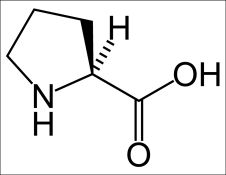
Proline
The problem lies in the actual reaction mechanism. A primary amine forms an imine when reacted with a ketone, while a secondary amine can`t do that. A
secondary amine forms an enamine with a ketone – if it can!
There's at least one requirement for this: the ketone should be enolizable. If not, then there`s no reaction.
My trials showed evidence of this.
Benzophenone and benzil don`t have enolizable H-s. They were the most unsuitable compounds for the catalysis of this reaction.
This also explains why I expect them to behave differently in the continuation of these trials. I plan to use another amino acid too, a primary one,
in the next part of the experiment, besides proline.
The inability of menthon to act as a good catalyst can`t be attributed to the lack of enolizable hydrogens obviously.
I think it is a result of some sort of steric effect. Its isopropyl group may effectively interfere with the bond formation of the keto group. Maybe
it would be OK with a less bulky secondary amine but proline seems to be “too much”.
Camphor is not much better in this regard but it has different substitution on the alpha-C next to the keto group and it showed some activity. It
would be interesting to test both 2-methyl- and 2-ethyl-cyclohexanone in this reaction. We might find a trend.
Carvone of spear mint oil also has a methyl on the alpha-C so it may be “doomed” too!
(While I was compiling this report, I came across an interesting article by chance. [3] It shows that among various substituted
(bi)cyclic ketones cyclohexanone is the most reactive in a particular hydrolysis reaction. It is also remarkable how sensitive that model reaction is
to steric hindrance even from a single methyl group on the alpha-C of those ketones! It may be possible that something similar is at play in this
decarboxylation reaction and in that case one might not find easily a better catalyst than cyclohexanone among the substituted cyclic ketones!
The continuation of the above mentioned article [4] suggests that maybe a 4-substituted-cyclohexanone could be better for our
purposes. The synthesis of such a ketone would be doable even for amateurs except one step: the hydrogenation of the benzene ring of the appropriate
phenol!
For a better catalyst an amateur should probably focus his search on the open-chain aliphatic or substituted aromatic methyl-ketones!)
The most unexplainable thing among my results is the question of “reversibility”. I couldn`t find a better term for this phenomenon.
All the tested compounds (except the inactives and cyclohexanone) showed this behaviour so it can`t be attributed entirely to some sort of silly
measurement error I think.
The phenomenon goes like this:
At the very beginning of the reaction the evolution of CO2 is the fastest. Always, with every catalyst. (It probably involves a small
measurement error too due to trapped air in the flask/condenser/tubing mixing with CO2 and bubbling into the gasometer.
This is why I started collecting CO2 above 110 Celsius reaction temperature but perhaps it was not enough. If I had started collecting
CO2 around 140 C it could have helped but maybe the effect still could have been seen.)
Then, afer this air-mixed CO2 bubbles out into the gasometer the “reversible” cyclohexanone shows a fairly constant bubbling rate until
around 80 – 90 % of the whole captured CO2 has been evolved. (Graph 1.) Then comes a fairly steep decline and the reaction ends.
The other, “irreversible” catalysts show a fairly quick decline in bubbling rate from the beginning , then the reaction hangs. No more
CO2 evolves.
But if at this point I add the usual 10 mmol cyclohexanone into the system it starts bubbling again and bubbles until the reaction is over (the
proline is consumed).
I use the term (ir)reversible because I think the phenomenon is somehow related to the nature of enamine formation between the actual catalyst and
proline (or pyrrolidine). I “feel” that irreversible catalysts are actually consumed in the reaction because they bind too strongly (irreversibly)
to either proline or pyrrolidine or both. Hence their concentration is continuously declining and it causes the reaction rate to drop quickly. When
all the catalyst molecules formed the stable compound the reaction hangs.
But not all proline is consumed at this point (remember: the reaction starts with 100 mmol proline and 10 mmol catalyst) so there`s unreacted proline
(a lot) in the flask at this point. When I add the reversible (reversible bond forming?) cyclohexanone, the reaction kicks in again and usually goes
to completion.
At what point does the reaction hang?
Good question, especially if the above reasoning is right and not something entirely different plays tricks in the backround.
Catalyst Evolved CO2 until hang All evolved CO2 Ratio at hang
p-chloro-benzalacetone 100 ml 1450 ml 6.9 %
acetylacetone 420 ml 1395 ml 30.1 %
benzoin 155 ml 1445 ml 10.7 %
camphor 120 ml 1295 ml 9.3 %
cyclohexenone 405 ml 1025 ml 39.5 %
spear mint oil 295 ml 1395 ml 21.1 %
A few remarkable trends can be seen here.
At first look at the “all evolved CO2” column. Then recall that I started with 100 mmol proline.
A little math: during decarboxylation 1 mol amino acid releases 1 mol CO2. Then 100 mmol should release 100 mmol. At 25 Celsius this 100
mmol CO2 should occupy 2450 ml (or so). The stoichiometry of decarboxylation is such that while 1 mol CO2 evolves then 1 mol
pyrrolidine also evolves.
It may lead to carbamate formation:
2 pyrrolidine + CO2 ----> pyrrolidine-carbamate (?)
Something surely happens because in the end when I add aqueous HCl to the mixture it bubbles strongly.
So the net effect might be that around half of the freed CO2 is recaptured as carbonate (or carbamate? or mixed?). So we may expect only
around 1225 ml captured gas in the gasometer from 100 mmol proline. I captured more but maybe some of the excess can be attributed to the
heat-expansion of originally captured air. Or the heat-instability of the carbamate/carbonate salts.
Anyway, it is odd that benzoin and camphor are so close to the 10% mark. It whispers me that the reaction hanged after 10% of proline had been
decarboxylated. But 10% of proline is 10 mmol, which is the ammount of the catalysts used in those reactions!
So 10 mmol pyrrolidine was released, it may irreversibly fixed up the 10 mmol catalyst (maybe as an enamine) and the reaction hang. It also might mean
that 10 mmol base was removed from the system as possible CO2 scavenger and it resulted in 5 mmol more CO2 available as gas for
the gasometer. Which is 122 ml CO2 at that temperature and pressure.
More oddities: you can see that in the “ratio at hang” column the values are not really random numbers but are disturbingly close to integer
multiples of 10!
(Except the p-chloro-benzal-acetone, but it was an unpleasant reaction anyway, it formed a “melt chewing gum”-like mass from the proline. None of
the other catalysts did this, so it might mean there was another unknown sidereaction which consumed some of the catalyst before it had chance to
decarboxylate anything.
It may also mean that this compound is exceptionally good at forming the enamine (= releases water very quickly and transforms the dry proline powder
into a gum-like mass).
Also, there was a gas leak during this experiment, and a few tens of millilitres of CO2 could had easily escaped before I repaired that
leak so it just might hang at 10%.) :-)
I have no theories to explain the 20, 30, and 40 % “ratio at hang” things, but again, I'm open to suggestions. Someone might come forward with a
“Unified Theory of Hangs”. :-)
What next?
As you can see the reaction is far from boring. One can measure a lot of things and fabricate nice theories based on those measurements. If these fail
one can still purify the end product and got rewarded by a smelly amine.
I plan to do a more thorough investigation in this field. Scale would be lowered to one tenth / one fifth of the current one. There would be
repetitions of the same reactions. There would be a primary amino acid included. /Which one I`m not decided yet./ There would be a septum used instead
of the current “pull the glass stopper – plug it back” method. The pickle jar would be retired and a measuring cylinder would be used instead.
Dilute acid solution (instead of plain tap water) would be used to capture CO2. I also plan to extend the range of used ketones. I can`t
believe that there`s no better catalyst than cyclohexanone. Maybe a properly substituted acetophenone would be the winner.
This opens up the possibilities for “collaborative experimentation” as Sulaiman already suggested in another thread. (http://www.sciencemadness.org/talk/viewthread.php?tid=103836... https://www.sciencemadness.org/whisper/viewthread.php?tid=10...)
If someone prepared a promising candidate I would happily test it in my setup. I also have yet another ketone from a synthesis waiting for
purification in a flask.
Then there`s this reversibility issue. Is it a special proline feature or is it the same with primary amines as well? Is there a way to avoid reaction
hang-up? What is the exact cause of this?
Readers probably would come up with other interesting ideas/questions too. I`m open to suggestions and would like to learn how the professionals would
approach this reaction!
Preparations
p-chloro-benzal-acetone
[7][8]
I measured 2.6 g (18.5 mmol) p-chloro-benzaldehyde and 4.0 g (69 mmol) acetone into a 50 ml Erlenmeyer flask. The aldehyde dissolved fully in the
aceton within 2 minutes. I also measured 23.0 ml 10% NaOH solution into a 50 ml beaker and with stirring turned on I poured this solution into the
aldehyde solution. Heating was turned on and temperature set to 100 Celsius. I put a reflux condenser onto the flask with circulating water as coolant
(water temp. was around 20 Celsius).
The reaction started quickly, at first white precipitate formed then its colour turned to sulfur yellow. During this time the contents of the flask
started to boil because the reaction is exothermic and the hotplate also quickly reached the set temperature. I was lucky and no overboil happened,
but more care would be needed next time.
I continued stirring and gently refluxing the mixture in the flask for an hour. At the end of the hour orange coloured oily droplets sank to the
bottom. I let the system cool for a few minutes, removed the condenser and removed the flask too. Then added a little dilute (8-10%) HCl solution to
the flask to neutralize most of the NaOH. This dilution/cooling caused the product to aggregate into small, yellow balls. The salt solution was
decanted, then I washed it again with tap water (20 ml) until the pH became close to 7. It required an additional heating/melting then re-cooling
cycle on the hotplate with stirring.
The product was not crystalline yet, it formed an amorphous mass with a nice yellow colour. Tried to recrystallize the mass from MeOH, but failed: the
solubility was too low. So I evaporated the methanol and let the sulfur yellow honey-like liquid to stand at room temp for 24 hours. By next day most
of the product crystallised and only a small part of the mass was still honey-like. It had a faint, cumin-like smell. I didn't check its melting point
because it was not a clean product and I didn't see the reason in recording/reporting a way off mp value. On the other hand for my evaluation purposes
I regarded that crystall mass suitable.
Benzoin
[9][10][11][12][13]
For the synthesis of benzoin I had to prepare some cyanide first. (I know thiamine could be used too but wanted to prepare some cyanide and it was a
good excuse for that.) It was in itself an interesting synthesis. Here's how it went:
I measured 6.500 g K4[Fe(CN)6]x3H2O into the bottom of a glass petri dish then heated it on a hotplate around 100
Celsius for 1-2 hours in order to remove the crystal water. After cooling the measered mass was 5.674 g.
Mtrihidric = 422 g/mol, Manhidric = 368.4 g/mol. Expected anhidric mass (from 6.500 g trihidric) = 5.669 g. Difference: +0.08%,
seems OK.
Reaction: K4[Fe(CN)6] + Na2CO3 ------> 4 KCN + NaCN + Fe +
CO2 + NaOCN
According to the preparation recipe 4 parts of anhydrous ferrocyanide and 1 part anhydrous Na2CO3 should be mixed and then melt
together and heated until no more CO2 bubbles from the melt. This way one can produce 8.8 parts cyanide along with 2.2 parts of cyanate.
(And some fine Fe powder. The product is a so-called “mixed cyanide” because it contains both sodium and potassium ions. It is sometimes better
than a pure cyanide because it melts at a lower temperature and is easier to work with.) Don't take the above stoichiometric equation too seriously
thoug! There are dozens of different ones circulating in the papers and the process is probably more complicated than this. According to e.g. Boffis
CO also evolves and only 70% of the cyanide can be recovered. Anyway, I only needed just a small ammount of cyanide ions so this half-true equation
was sufficient for me. :-)
I mixed 2.0 g ferrocyanide and 0.5 g Na2CO3, put the mixed fine powder (was mixed and powdered in a mortar with a pestle) into a
standard glass test tube and started heating on direct gas flame. At first the white powder became black then melt. It started fizzing (actual
bubbling was hard to see because the dense, black melt quickly obscured the sight). I kept the test tube at good visible red heat for 20 minutes or
so, then turned off the gas. It was still fizzing but I was afraid of a possible test tube failure (red heat) and decided to stop at that point. I let
the test tube cool in free air and at a point I heard a familiar “click” sound. I kinda expected it from the solidifying cyanide to break the
glass but I still felt sorry for the test tube.
After cooling down I added small ammount of water (2-3 ml) to the tube and started cautiously swirling the water around the wall of the tube to
dissolve the cyanide. It dissolved fairly easily and the Fe powder sank to the bottom. Purification was easy: filtering through filter paper. I
repeated the dissolution-swirling-filtering procedure two or three more times and in the end I got around 8-10 ml cyanide solution. I checked the
cyanide content with FeSO4 solution and it produced a thick, deep blue precipitate immediately. At this point I could be sure I had enough
cyanide for the benzoin dimerisation.
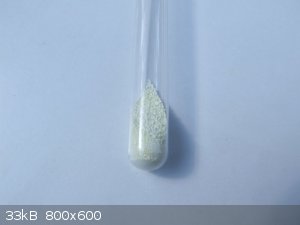
Starting mixture in a test tube.
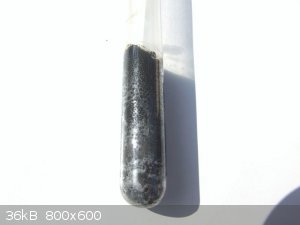
After heating for 20 minutes and cooling. You might even see the crack on the tube a bit above center, horizontal line, on the left side.
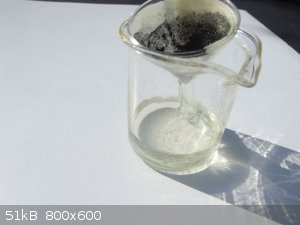
Nice, clear cyanide containing solution.
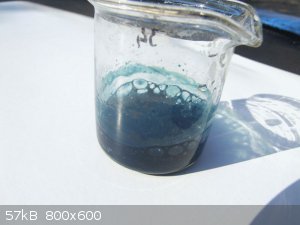
The prussian blue test of around 1 ml of the filtrate. It is blue enough I think.
Dimerisation:
Into a 100ml round bottom flask I measured 10.1 g benzaldehyde and 20 ml denatured alcohol. (Denaturant: 2% MEK.) The benzaldehyde was not previously
distilled or purified in any way, it was straight from a 20+ year old small glass bottle. I also added 5 ml cyanide solution (see above synth) to this
benzaldehyde solution. I had it stirred on a magnetic stirrer hotplate under gentle reflux. The initially white opalescent liquid turned yellowish
within 10 minutes. After 90 minutes intensive stirring I turned off the heating and let it cool. It formed a yellowish, sticky-crumbly mass upon
cooling.
I filtered the mass (with resuspension) on a Buchner filter and washed three times with distilled water on the filter until the prussian blue reaction
of the filtrate became negative. Three washings were enough. Recrystallized from ethanol, roughly 65 ml ethanol was used for this.
The mass of the dried product was 6.9 g. Yield: 68%. Melting point: 134.5 – 134.9 Celsius. (literature: 134 – 138 C) Almost white crystalline
powder with no odour.
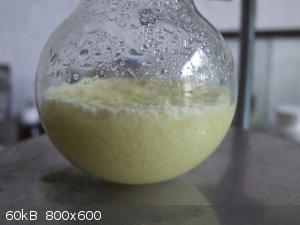
Crude benzoin cooling in the flask.
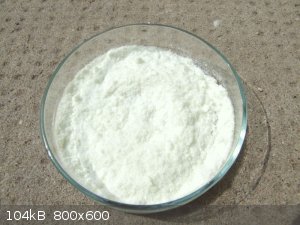
Recrystallized benzoin in a petri dish.
Benzil
[14]
I suspended 4,0 g benzoin into 10ml cold 50% nitric acid in a 50 ml Erlenmeyer flask. While cold there was no appreciable reaction. On slow heating
the benzoin melt, turned reddish orange and the mixture started to emit NOx. After 30 minutes of gentle warming (around 60-70 Celsius) the
upper organic phase was reddishbrown, the lower aqueous acid was orange. After another 30 minutes the acid layer lost most of its colour while the
organic layer brightened to strong yellow / faint orange. At this point the Fehling reaction was negative. (The starting material benzoin did show a
positive reaction, I checked that.)
I let the mixture cool, diluted with some cold water and filtered on a Buchner filter. I washed the yellow crystalls with water again, then
recrystallized the still somewhat wet mass from denatured alcohol. 15-20 ml alcohol was used for this.
Mass of dried product: 3.4 g. Yield: 85%. Melting point: 92.1-93.6 Celsius. (literature: 94-96 C)
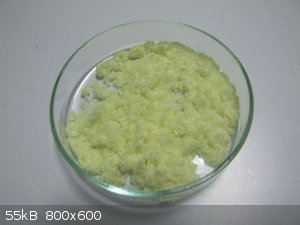
Recrystallized benzil in a petri dish.
Menthone
[15][16]
Into a 250ml round bottom flask I measured 10.0 g levomenthole and with slow stirring turned on I dissolved it in 30 ml 96% acetic acid. (Dissolution
was fairly endothermic, dew droplets appeared on the outside of the flask.)
I could only buy dilute 1-2% hypochlorite solution and decided to strengthen it by calcium hypochlorite. Simply mixed in some calcium hypochlorite
powder into a cup of dilute sodium hypochlorite, stirred it with a glass rod, let it sit for a few minutes then filtered it through a wad of rockwool
put into a plastic funnel.
By continuously cooling the flask with cold water (around 15 Celsius or so) I slowly added 100 ml of this filtrate from a dropping funnel to the
flask. It took almost 2 hours to do this, I think I was too cautious. (Previously I determined the active chlorine content of this mixed hypochlorite
solution by iodometric titration and got 0.691M.)
At the end of the reaction the iodide-test was positive. Added some K2S2O5 powder to the flask until the iodide-test
became negative. Then strarted to neutralize the acetic acid by cautiously adding small ammounts of Na2CO3 powder until the
bubbling subsided. Then about 25 ml water was needed to make the extraction by chloroform possible. (thickening.) I extracted the mixture three times
with 16-18 ml chloroform, the extracts were pooled, dried with anhydrous Na2SO4, filtered and the bulk of the chloroform
distilled off. After about 30 ml chloroform was recovered the temperature of the vapour started to decrease. I dismantled the distilling apparatus and
poured the remaining menthone-chloroform mixture into a beaker and finished the evaporation of chloroform on a hotplate set to around 50 Celsius.
(worked outside!) Got roughly 10 g crude product. (So it seems I could recover practically all menthone and menthol with the extraction.)
Tried to purify the menthone by steam distillation. Poured it into a 100 ml round bottom flask, added roughly 50 ml water and started stirring and
heating. Colourless oily droplets condensed with water and were collected in a big test tube. I siphoned off water with a pipette from under the
distilled oil. The remaining water was absorbed by a pinch of anhydrous Na2SO4. I let the oil dry for a day, with ocassional
swirling. The dried product was decanted from the salt.
Mass: 7.2 g. Yield: 72%. Menthone melts at -6 C so I could not meausre its mp. What I got is a nice, menthole-smelling liquid.
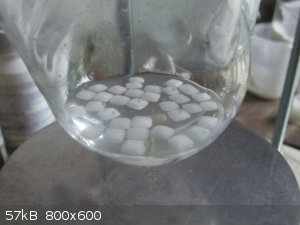
Dissolving menthole prills in acetic acid. They dissolved in two minutes.
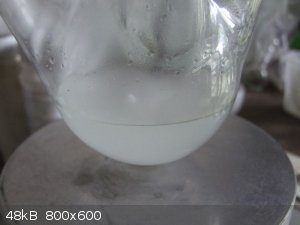
Finished menthone preparation. You may see a thin layer of menthone oil on top of the acid. The white blobs are Na2CO3 lumps.
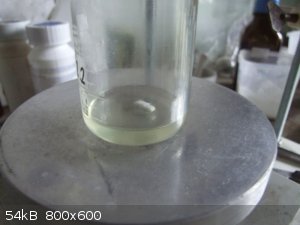
Crude menthone while evaporating chloroform.
Cyclohexenone
[2]
I assembled an O2 generator at first: into a 500 ml flat bottom flask (generator body) put a distillation vacuum-adapter and on the top of
this adapter a dropping funnel was inserted. To the vacuum side-arm of the adapter a flexible plastic tube was attached. The other end of this tube
ended in a ground glass gas inlet tube in the reaction flask, a 2000 ml two neck round bottom flask.
To the other neck of the reaction flask another flexible plastic tube was attached and it ended in a water filled gasometer. (The usual 2 litre
pickle's jar mouth down filled with water in a big bucket of water, hevy brick on top to prevent the jar from falling over.)
Before the reaction was started I put 1,0 g MnO2 (powdered pyrolusit, actual MnO2 content 93%) into the generator flask and
measured 80 ml 30 % H2O2 into the dropping funnel – tap strictly closed if you want to avoid surprises! :-)
I also measured 23 ml cyclohexene (previously made from cyclohexanole and phosphoric acid /sulphuric acid, another interesting synthesis on its own)
and added 2,00 g analytical grade Cu(II)-acetate as a fine powder to the cyclohexene in the reaction flask. A big, oval shaped teflon coated magnetic
stirring bar was also placed cautiously into this flask. The end of the O2 inlet glass tube was not immersed into the liquid, it ended at
about 5 mm above the surface of cyclohexene. After a final inspection of the proper fitting of the ground glass joints I started stirring the
cyclohexene quite intensively: the stirring bar made small droplets from the liquid and these droplets trickled back from the inner surface of the
flask. (To promote absorbtion of O2 into the liquid.) To my surprise the copper acetate dissolved somewhat in the dry cyclohexene, the
liquid became faint blue in a few minutes.
Then I started the reaction by very cautiously opening the tap of the dropping funnel and let the peroxide drip onto the MnO2. The first
few drops were somewhat frightening I admit but later, as more and more water diluted the pyrolusit powder it tamed and the generator worked
satisfactorily.
I filled the gasometer jar twice with the air/oxigene mixture from the generator/reaction flask/tubings and then released this gas into the air. Then
I filled it again but this time this gas was not released. It became the “chamber gas” or “reaction gas” for the coming days.
Unfortunately I could not put a thermometer into the cyclohexene but the temperature of the hotplate was around 60-70 Celsius. (guesstimate)
After 24 hours the reaction mixture showed only minimal signs of change: the blueness of the copper compound became a bit deeper. At 36 hours though
the change was striking: the liquid became blackish green and something black, goey-like substance was clearly visible. On the sides of the flask the
dripping back liquid was no more blue, the colour turned to yellow like the yellow of dilute FeCl3 solution. At 62 hours I decided the
reaction was over and turned off the heating but stirring was still on.
Washed the liquid in the flask with FeSO4 solution (in the hope to destroy organic peroxides) and separated the oily phase in a separation
funnel. It was a bit tricky because both phases were almost the same: brownish black! Fortunately there was a slight difference in the colour of the
two phases and they were separated nicely. No nasty emulsion, nothing.
Then I distilled the organic phase. At first the excess of cyclohexene came then I collected another two fractions. The temperature of these fractions
were not recorded because there was water in the system so it was more like steam distillation.
The composition of the first fraction was confirmed by TLC, it was essentially pure cyclohexene. (20% acetone – 80% petrolether 80-100, Merck Art.
5554 DC-Alufolien Kieselgel 60 F254, iodine vapour): no spot was visible either from pure cyclohexene standard or the first fraction. I
know it sounds much like “the lack of evidence is not evidence of non-existence”-or what, but it was sufficient for me at this point. If I had a
better TLC method for detecting cyclohexene I surely would choose that.
The smell of the fractions was also a telltale, the third fraction was the worst. I mean really unbearable, almost made my stomach move upwards! I
hate the stench of pure cyclohexene too, but this was definitely worse. Do this experiment in a good fume hood or (as I did) outside! (LD50
of cyclohexenon is around 200 mg/kg, it is a poison!)
A few milliliters of black, viscous (resembling to glycerine in this respect) “oil” remained in the distilling flask. I think something still
could be steam distilled from this mixture but I thought I had enough for the test.
The composition of the third fraction on the above TLC system showed three spots. The slowest (most polar) was the bulk (Rf:0-0.42), then there was
two much smaller but distinct spots above this (Rfs: 0.45-0.54, 0.58-0.64). The quantity of the bulk overwhelmed the plate, it showed a continuous
streak from start to 0.42. Or was it the water in the sample?
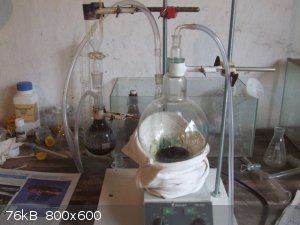
Cyclohexenone making machine. O 2 generator on the left, reaction flask on the hotplate. Picture was taken at the end of the reaction. You
can see the blak reaction mixture in the flask.
Literature
1. A NOVEL DECARBOXYLATION OF α-AMINO ACIDS. A FACILE METHOD OF DECARBOXYLATION BY THE USE OF 2-CYCLOHEXEN-1-ONE AS A CATALYST
M. Hashimoto, Y. Eda, Y. Osanai, T. Iwai, and S. Aoki
Chemistry Letters 15, issue 6, pp. 893-896 (1986)
DOI: 10.1246/cl.1986.893
2. Copper-catalysed allylic oxidation of cyclohexene with molecular oxygen
Xu Zhang, Rong Yi, Tian Chen, Schichun Ni, Genlin Wang, Lei Yu
Scientific Yournal of Frontier Chemical DevelopmentJune 2013, Volume 3, Issue 2, pp. 25-29
3. Structure and properties of cyclic compounds. X. Dissociation constants of cyanohydrins of some bridged ring ketones
O.H.Wheeler, R Cetina, J.Z.Zabicky
JOC, October 1, 1957, Volume 22, Issue 10, pp 1153–1156 DOI: 10.1021/jo01361a004
4. Structure and properties of cyclic compounds. XI. Dissociation constants of cyanohydrins of some methylcyclohexanones
O.H.Wheeler, J.Z.Zabicky
Canadian Journal of Chemistry, 36, pp. 656 (1958)
DOI: 10.1139/v58-091
5. Rapid Conventional and Microwave-Assisted Decarboxylation of L-Histidine and Other Amino Acids via Organocatalysis with R-Carvone Under Superheated
Conditions
Douglas M. Jackson, Robert L. Ashley, Callan B. Brownfield, Daniel R. Morrison & Richard W. Morrison
Synthetic Communications Volume 45, 2015 - Issue 23 Pages 2691-2700
DOI:10.1080/00397911.2015.1100745
6. Schiff bases. Part I. Thermal decarboxylation of α-amino-acids in the presence of ketones
A. F. Al-Sayyab and Alexander Lawson
J. Chem. Soc. C, 1968,0, 406-410
DOI:10.1039/J39680000406
http://www.sciencemadness.org/talk/files.php?pid=502939&...
7. Systematic Organic Chemistry
W. M. Cumming 99, 1937.
http://www.prepchem.com/synthesis-of-benzylideneacetone/
8. Preparative organic chemistry lab.manual from a local university
9. Benzoin
N.L. Drake and P. Allen, Jr.
Org. Syn. 1923 3, 17
DOI:10.15227/orgsyn.003.0017
http://www.orgsyn.org/demo.aspx?prep=cv1p0077
10. Introduction to the preparations of organic compounds
E. Fisher 62, 1909.
http://www.prepchem.com/synthesis-of-benzoin/
11. Magpie's work on benzoin
http://www.sciencemadness.org/talk/viewthread.php?tid=19160
12. Laboratory manual of inorganic preparations
H. T. Vulte, 50-51, 1895.
http://www.prepchem.com/synthesis-of-potassium-cyanide/
13. The cyanide-thread on SM
http://www.sciencemadness.org/talk/viewthread.php?tid=23&...
14. Introduction to the preparation of organic compounds
E. Fisher, 62-63, 1909.
http://www.prepchem.com/synthesis-of-benzil/
15. Convenient and inexpensive procedure for oxydation of secondary alcohols to ketones
R.V. Stevens, K.T. Chapman, H.N. Weller
J. Org. Chem. 45, 2030-2032 (1980)
DOI:10.1021/jo01298a066
16. The oxidation of alcohols and ethers using calcium hypochlorite
S.O. Nwaukwa and P.M. Keehn
Tet. Lett. 23(1), 35-38 (1982)
DOI: 10.1016/S0040-4039(00)97525-7
|
|
|
morganbw
National Hazard
   
Posts: 561
Registered: 23-11-2014
Member Is Offline
Mood: No Mood
|
|
This is a bit more than I can digest in one sitting.
This looks to be a very interesting post and I will come back and chew on it as I can.
Thank you.
[Edited on 12/16/2018 by morganbw]
|
|
|
DavidJR
National Hazard
   
Posts: 908
Registered: 1-1-2018
Location: Scotland
Member Is Offline
Mood: Tired
|
|
Very interesting!
|
|
|
Loptr
International Hazard
    
Posts: 1347
Registered: 20-5-2014
Location: USA
Member Is Offline
Mood: Grateful
|
|
Thank you for your work. This is very interesting and something I would like to attempt.
"Question everything generally thought to be obvious." - Dieter Rams
|
|
|
Pumukli
National Hazard
   
Posts: 686
Registered: 2-3-2014
Location: EU
Member Is Offline
Mood: No Mood
|
|
I thought I would get more criticism by now. Over 2000 views and not a single frown upon. :-)
Anyway, I continued the tinkering with this reaction during the past few weeks. In the end I had ordered a flask custom made by a glassblower because
I could not find such a flask in my inventory and not even in the catalog of lab supplies due to its parameters. (volume, number of necks, size of
ground glass joints on those necks).
Man, this catalyst hunt getting more and more expensive by the day! :-)
The flask is ready as I was told this morning and I payed for it so theoretically within a few days I can start working with it. (Waiting for the
courier.)
Meanwhile I acquired a few more promising candidates: acetophenone, diisobutylketone and carvone.
I put together a reduced size arrangement for the testing and retired the pickle jar and substituted it with a 250 ml measuring cylinder. This way I
could use 14 mmol proline instead of the original 100 mmol, so it is now on a 1/7th scale.
Unfortunately my 100 ml flasks has only one neck and ideally I would need three. (The new flask will have those two "extras" what I need.)
Anyway, I could not resist the smell of these new catalyst candidates and run some preliminary tests in the new setup, although crude, but to my
surprise still very informative!
It seems that acetophenone has a pronounced induction period at the beginning and gains momentum slowly but afterwards it works nicely. Like a mule.
In contrast, cyclohexanone has almost zero induction period and works at full-throttle from the start but looses the speed in the later stages of the
conversion. Like a cheetah. To illustrate this here's some data:
Cyclohexanone: time to 50% conversion: 45 mins, to 90%: 270 minutes.
Acetophenone: time to 50% conversion: 131 min, to 90%: 277 minutes.
(14 mmol proline, 1.4 mmol catalyst, 20 ml solvent. T roughly the same.)
Incidentally, the above data-pairs show the futility of my efforts too: the initial rate constant means nothing. If I want to compile a nice table
with rate constants from WHICH point of the reaction curve should I pick that constant?
Cyclohexanone is more than 3 times as quick initially as acetophenone but still, they finish the reaction almost at the same time!
From the point of view of the synthetic chemist they are practically the same: they transform a given ammount of substrate during the same time
period.
(Of course, they may not be the same at all, but we need more data. E.g. it is possible that they finish the conversion during the same period but one
may produce a cleaner product! I did not check the purity of the product, but I can tell qualitatively that acetophenone produced a less coloured
reaction mixture.)
I also came up with a hypothesis about the cause of the hang-ups but I need more tests. :-)
All in all, this is an ongoing project and I will write another detailed report when I will have new and interesting info to share.
|
|
|
Pumukli
National Hazard
   
Posts: 686
Registered: 2-3-2014
Location: EU
Member Is Offline
Mood: No Mood
|
|
You remember that I used spear mint oil in the first series of tests but wanted to sound more scientific and referred to it simply as "carvone"!? 
I also wrote that I assumed that the oil contained roughly 50% carvone so I corrected the used mass accordingly.
Now that I have some pure R-carvone I thought I would check it too.
...It went well and got a nice reaction curve with not too shabby performance characteristics, after all the junk from the oil was spared from the
trial, right?...
WRONG!!! 
I tested the pure carvone with exactly the same method I used for testing cyclohexanone, acetophenone and diisobutylketone. The trial showed that
carvone DOES NOT WORK as a decarboxylation catalyst for proline at all! (Actually: less than 2% conversion after 160 mins. For any practical purposes
it means a big zero.)
The result suggests that in spear mint oil carvone is not the active compound when it comes to decarboxylation.
Could anybody confirm my result? I'm so surprised at the moment that I can't stop questioning what I found.
|
|
|
AvBaeyer
National Hazard
   
Posts: 644
Registered: 25-2-2014
Location: CA
Member Is Offline
Mood: No Mood
|
|
It is important to note that spearmint oil contains S-carvone. Could it be that the decarboxylation of S-proline (I am assuming you are using natural
proline) is sensitive to the chirality of the catalyst?
How do you know that your R-carvone is really R-carvone ? If you wanted to test R-carvone as a catalyst, then you should try carraway oil. Has any one
tried carraway oil that you can document?
If you find that carraway oil does not work, you have a very interesting discovery relating to the effect of chiral catalysts on decarboxylation. Next
step would be to test pure S-carvone against pure R-carvone (which you presumably have).
See here: https://www.acsh.org/news/2018/08/01/carvone-one-molecule-tw...
AvB
Edit: Something you might find interesting. A while back I wanted to use proline as a basic catalyst to react benzaldehyde with acetophenone. Upon
heating the reaction mixture in ethanol to about 65 C, CO2 was rapidly evolved. Further research turned up a number of papers regarding the facile
decarboxylation of proline by various carbonyl compounds. Have you done a literature search on proline decarboxylation? I found the references using
Google and Google Scholar.
AvB
[Edited on 19-1-2019 by AvBaeyer]
|
|
|
Pumukli
National Hazard
   
Posts: 686
Registered: 2-3-2014
Location: EU
Member Is Offline
Mood: No Mood
|
|
Thanks AvBaeyer for the tips.
What I have says L-carvone , food grade, min 97% on the bottle. BUT its smell is more resembling to caraway than to spearmint. I had it "smell tested"
with another person and the result was the same: caraway, maybe dill, but not chewing gum (spearmint).
According to wikipedia https://en.wikipedia.org/wiki/Carvone the two carvone isomers can be discriminated by smell! Not all smelly stereoisomeric compounds can be
distinguised by smell, but carvone is such one.
Chances are what I really have is the S (D) isomer! I will ask the seller what he knows about this. :-) Maybe just a mislabelling issue. :-) (It is
from Ebay.)
I supposedly use S-Proline. It is also from Ebay but from a different supplier and I assume it is harder to find the non-biogenic R amino acids in a
health food shop than the natural isomers. :-)
|
|
|
AvBaeyer
National Hazard
   
Posts: 644
Registered: 25-2-2014
Location: CA
Member Is Offline
Mood: No Mood
|
|
Here is a very interesting patent which might help you along, at least conceptually. Interestingly, it is shown that both R- and S-carvone are
effective catalysts. The synthetic method used is not easily adapted to the amateur lab, but I believe the chemistry is solid.
A follow-on paper has also been published in Synthetic Communications:
doi.org/10.1080/00397911.2015.1100745
AvB
Attachment: Amino acid decarboxylation method US2014275569A1.pdf (859kB)
This file has been downloaded 622 times
[Edited on 20-1-2019 by AvBaeyer]
|
|
|
Pumukli
National Hazard
   
Posts: 686
Registered: 2-3-2014
Location: EU
Member Is Offline
Mood: No Mood
|
|
Thanks for the patent!
I've seen this somewhere but dismissed on the basis of non-amateur-friendliness. :-)
I would like to find the best method for amateurs. This is why I use the low (0.1 equivalent) catalyst loading.
And this is why I use kerosene as reaction "solvent". It does not dissolve the amino acids but interestingly it clears up when the reaction is
finished! (Similarly to cyclohexanol, as the patent mentioned too.) Unlike cyclohexanol, the kerosene can be removed with a simple acidic water
extraction! It is possibly the most amateur friendly way to get to the aqueous solution of crude amine-salts. Yes, I tried cyclohexanol but it was a
pain to distill the pyrrolidine from this solvent! And cyclohexanol can't be removed with an extraction...
I tried to use my ?-carvone to decarboxylate L-leucine at the weekend. Reasoning behind this was that unlike the rigid proline ring the open-chain
isopentyl-amine might have more freedom to acquire a good fit with the carbonyl-group.
And it worked somewhat! The reaction started but hang at around 10% conversion. But at least it started, that's sure.
Then I tried to use glycine! Of course the reasoning behind this was that with a non-chiral substrate the conformation of the catalyst shouldn't be
important.
Well, it did not worked at all! Then I added the beloved cyclohexanone to the mixture - but it also failed to start the bubbling! This was the first
time in my trials when this catalyst failed!
|
|
|
SplendidAcylation
Hazard to Others
  
Posts: 196
Registered: 28-10-2018
Location: Starving in some deep mystery
Member Is Offline
Mood: No one I think is in my tree.
|
|
Quote: Originally posted by Pumukli  |
Acetophenone: time to 50% conversion: 131 min, to 90%: 277 minutes.
(14 mmol proline, 1.4 mmol catalyst, 20 ml solvent. T roughly the same.)
|
Fantastic efforts Pumukli!
This part, in particular, interests me, as I don't have a lot of acetophenone, and this is the only reference that I have found to the use of
acetophenone in catalytic quantities for this reaction, as opposed to using the acetophenone as a solvent, or in equimolar quantities.
Do you suppose there is any advantage to using larger quantities of acetophenone than you have used?
My efforts at the synthesis of acetophenone by pyrolysis of Fe(II) salts has yielded about 7g of acetophenone after about 3 weeks of work    so I really don't want to go back to the beginning to make any more hehe. so I really don't want to go back to the beginning to make any more hehe.
|
|
|
Pumukli
National Hazard
   
Posts: 686
Registered: 2-3-2014
Location: EU
Member Is Offline
Mood: No Mood
|
|
I'm glad that at least one man found my efforts worthwhile. :-)
The "catalytic ammount" of ketones arose from the same problem: I did not want to waste precious compounds (acetophenone) as solvent... So I started
to test them in much lower, "catalytic ammounts".
Acetophenone performed as one of the best catalysators (so far), second best being cyclohexanone.
If you use it in larger quantities you can save time, basically. 10% (molar%) requires several hours diligent refluxing to get the reaction done. 100%
probably finishes in an hour or so... I thought I'd rather trade time and electricity (and mechanical stress to my hotplate) but want to conserve
acetophenon as much as I could.
There are other "catalysators" (other ketones) that are much inferior in performance in this reaction. You should use those in much higher ratio, even
in excess, if you wanted the reaction done. With acetophenone or cyclohexanone (and probably with a lot more other compounds that are still remain to
be tested) one can get away with a real "catalytic" ratio, say 10%.
|
|
|
dicyanin
Hazard to Self
 
Posts: 57
Registered: 29-3-2020
Location: Europe
Member Is Offline
Mood: inquisitive
|
|
It's perhaps a bit late, but I would like throw in my two cents.
In my experiments I've always succesfully used pure D-carvone as the decarboxylation catalyst, which using modern naming corresponds to S-(+)-carvone.
It was isolated by fractional distillation from Indian dill essential oil (Anethum sowa) which contains 40-60%, but it can also be obtained from the
more commonly available caraway seed essential oil (Carum carvi) where it is the principal constituent (60-70%).
I've found it to be a particularly trustworthy catalyst. Acetophenone also performs well, but the intermediate imine is more stable, which can be
troublesome in the final isolation step. Menthone (isolated from corn mint, Mentha arvensis) and camphor were also tried but with disappointing
results, and acetone was found unsuitable because its low boiling point.
Mineral spirits (C7-C12, boiling range 130-220°C) and kerosene can be used, but pine turpentine is a preferable solvent. Also the use of a small
amount of DMSO as co-solvent/promotor is recommended, it seems to make a lot of difference to obtain good and reproducible results. You don't need
much, about 5% DMSO in pine turpentine.
Paper chromatography is a good, cheap method for monitoring this reaction. Cellulose molecules carry hydroxyl groups which are readily available for
hydrogen-bonding, which makes it an ideal adsorbent for the separation of hydrophilic substances such as amines and amino acids.
Detection can be done with iodine vapors, or with selective reagents. Ninhydrin is particularly well suited for amino acids (except proline) and
amines (be sure to wear gloves  ). Alternatively, fluorescamine, Ehrlich's reagent
or Dragendorff's reagent can all be used to visualize amines, without being incompatible with the paper. Possibly vanillin/KOH/360nm UV as well. ). Alternatively, fluorescamine, Ehrlich's reagent
or Dragendorff's reagent can all be used to visualize amines, without being incompatible with the paper. Possibly vanillin/KOH/360nm UV as well.
[Edited on 16-2-2024 by dicyanin]
|
|
|
|